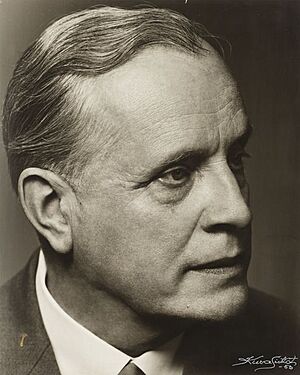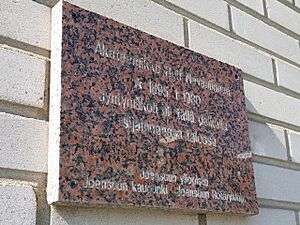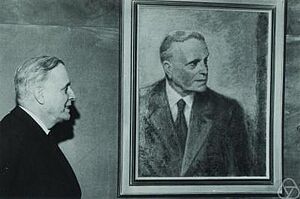Rolf Nevanlinna facts for kids
Quick facts for kids
Rolf Nevanlinna
|
|
|---|---|

Rolf Nevanlinna, 1958.
|
|
| Born |
Rolf Herman Neovius
22 October 1895 |
| Died | 28 May 1980 (aged 84) Helsinki, Finland
|
| Nationality | Finnish |
| Alma mater | University of Helsinki |
| Known for | Nevanlinna theory |
| Scientific career | |
| Fields | Mathematics |
| Thesis | Über beschränkte Funktionen die in gegebenen Punkten vorgeschriebene Werte annehmen (1919) |
| Doctoral advisor | Ernst Leonard Lindelöf |
| Doctoral students | Lars Ahlfors, Kari Karhunen, Leo Sario, Gustav Elfving, Olli Lehto, Kurt Strebel, Olli Lokki, Nazım Terzioğlu |
Rolf Herman Nevanlinna (born Neovius) was a famous Finnish mathematician. He lived from 1895 to 1980. He made very important discoveries in a part of mathematics called complex analysis.
Contents
Early Life and Family
Rolf Nevanlinna was born Rolf Herman Neovius. His family changed their name to Nevanlinna in 1906. His family had many mathematicians! His grandfather, uncles, and father were all involved in math or related fields.
His father, Otto, was a physicist, astronomer, and mathematician. Otto married Margarete Romberg. They had four children: Frithiof, Rolf, Anna, and Erik. Frithiof also became a mathematician.
Education and Music
Rolf started school at age seven. He already knew how to read and write. He went straight into the second grade. He found school boring at first and was homeschooled for a while.
In 1903, his family moved to Helsinki. Rolf went to a grammar school there. He learned French and German, adding to Finnish and Swedish, which he already spoke.
Rolf loved music, and his mother encouraged it. She was an excellent pianist. Rolf and his brother Frithiof would listen to her play. They both learned instruments; Frithiof played the cello and Rolf played the violin. They became skilled musicians.
Through orchestra school, they discovered music by great composers. These included Bach, Beethoven, and Sibelius. Rolf said that no one had a stronger effect on him than Sibelius.
Rolf then went to Helsinki High School. His main interests were classics and mathematics. His father taught him physics and math, and he was the best teacher. Rolf graduated in 1913.
That summer, he read a book called Introduction to Higher Analysis. This made him very interested in mathematical analysis. The author, Ernst Leonard Lindelöf, was also a cousin of Rolf's father.
Rolf began studying at the University of Helsinki in 1913. He earned his Master of Philosophy degree in mathematics in 1917. Lindelöf was his teacher and a big influence.
During World War I, Rolf wanted to join the army. But his parents convinced him to keep studying. He did join the White Guard during the Finnish Civil War. However, he did not fight in battles.
In 1919, Rolf finished his doctoral thesis. It was about complex analysis. He earned his Doctor of Philosophy degree on June 2, 1919.
Career and Discoveries
After getting his doctorate, Rolf became a school teacher. There were no university jobs available. His brother Frithiof also worked for an insurance company as a mathematician. Frithiof helped Rolf get a job there too.
In 1922, Rolf became a mathematics teacher at the University of Helsinki. He stopped his insurance job but kept teaching at the school. In 1926, he became a full professor at the university. Then he quit his school teaching job.
Even with all this work, Rolf made his most important discovery between 1922 and 1925. This became known as Nevanlinna theory.
From 1947, Rolf held a position at the University of Zurich. He also got a permanent job at the new Academy of Finland in 1948.
Rolf Nevanlinna's most important math work is the value distribution theory. This theory is about a type of function called meromorphic functions. These are functions that are mostly smooth but have a few special points.
The theory helps us understand how often these functions take on certain values. Rolf's theory has two main parts, called the Main Theorems. Simply put, they describe how values are spread out for these functions.
Rolf's article about this theory was published in 1925. Another famous mathematician, Hermann Weyl, called it "one of the few great mathematical events of the [twentieth] century."
When the Winter War started in 1939, Rolf helped the Finnish Army. He improved how they calculated artillery firing tables. His new method made calculations much faster. For this work, he received an award called the Order of the Cross of Liberty. He was very proud of this award.
Later, Rolf Nevanlinna also studied other math areas. These included the theory of Riemann surfaces and functional analysis. He wrote books on these topics. He also wrote a book about the Theory of Relativity for a general audience.
Rolf supervised at least 28 students who were getting their doctorates. His first and most famous student was Lars Ahlfors. Lars Ahlfors later won the Fields Medal, which is a very important math award. His winning research was based on Rolf Nevanlinna's work.
Rolf Nevanlinna received many honors for his work. He got honorary degrees from many universities around the world. He was also an honorary member of several math societies. An asteroid, 1679 Nevanlinna, is named after him!
Leadership Roles
From 1954, Rolf Nevanlinna led the first computer project in Finland.
He also served as President of the International Mathematical Union (IMU) from 1959 to 1963. He was also President of the International Congress of Mathematicians in 1962.
In 1964, Rolf helped reorganize the Academy of Finland. This was thanks to his connections with President Urho Kekkonen.
From 1965 to 1970, Nevanlinna was the Chancellor of the University of Turku.
Political Connections
Rolf Nevanlinna did not actively participate in politics. However, he was known to have certain political sympathies. He accepted a professor position at the University of Göttingen in Germany in 1936 and 1937.
During World War II, Finland sent a volunteer group to the Waffen-SS. In 1942, Rolf was chosen to lead a committee for this group. He said he accepted this role out of a "sense of duty."
After World War II, Rolf helped connect mathematicians from different countries. He organized a meeting in Helsinki in 1957. This was one of the first times Soviet mathematicians could meet Western colleagues after the war.
IMU Abacus Medal
In 1981, the International Mathematical Union (IMU) decided to create a new award. This award was for theoretical computer science. It was similar to the Fields Medal. The funding came from Finland.
The IMU decided to name the award the Rolf Nevanlinna Prize. It was given out every four years. However, in 2018, the IMU decided to change the name of the prize. Starting in 2022, the award is called the IMU Abacus Medal.
See also
- Harmonic measure
- Nevanlinna theory
- Nevanlinna class (functions of bounded type)
- Nevanlinna function
- Nevanlinna invariant
- Nevanlinna–Pick interpolation
- Nevanlinna's criterion
- Nevanlinna Prize



